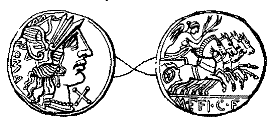Denarius
           | Please |help| us convert the |Dictionary of Roman Coins| from scans to text by typing the original text here. Please add updates or make corrections to the NumisWiki text version as appropriate. DENARIUS. - This well-known Roman coin derived its name from its value of ten asses (a denis assibus) when it replaced the quadrigatus at the time when the old cast aes grave coinage finally gave way to the new struck bronze coins circa 211 B.C. Around 141 B.C., the denarius was retarrifed at sixteen asses and retained this value into Imperial times. According to Pliny, it was established that the denarius should be given in exchange for ten pounds of bronze, the quinarius for five pounds, and the sestertius for two-and-a-half. - But when the as was reduced in weight to one ounce, it was established that the denarius should be given in exchange for sixteen asses, the quinarius for eight, and the sestertius for four. And though the reason for its being so called no longer existed, yet the denarius retained its original name. With respect to the weight of thje denarius, it appears, also according to Pliny and other writers, that there were, in the ancient libra, eighty-four denarii. The problems with Pliny's theory are cited (though unresolved) by Eckhel, and the chronology of Edward Sydenham, with regard to the Republic, has been revised by Michael Crawford in his Roman Republican Coinage. A specimen of a denarius of Augustus, struck at Rome about 19 B.C. by the moneyer M. Durmius is illustrated by the woodcut below.
|
View whole page from the |Dictionary Of Roman Coins|
Denarius
           | Please |help| us convert the |Dictionary of Roman Coins| from scans to text by typing the original text here. Please add updates or make corrections to the NumisWiki text version as appropriate. DENARIUS. - This well-known Roman coin derived its name from its value of ten asses (a denis assibus) when it replaced the quadrigatus at the time when the old cast aes grave coinage finally gave way to the new struck bronze coins circa 211 B.C. Around 141 B.C., the denarius was retarrifed at sixteen asses and retained this value into Imperial times. According to Pliny, it was established that the denarius should be given in exchange for ten pounds of bronze, the quinarius for five pounds, and the sestertius for two-and-a-half. - But when the as was reduced in weight to one ounce, it was established that the denarius should be given in exchange for sixteen asses, the quinarius for eight, and the sestertius for four. And though the reason for its being so called no longer existed, yet the denarius retained its original name. With respect to the weight of thje denarius, it appears, also according to Pliny and other writers, that there were, in the ancient libra, eighty-four denarii. The problems with Pliny's theory are cited (though unresolved) by Eckhel, and the chronology of Edward Sydenham, with regard to the Republic, has been revised by Michael Crawford in his Roman Republican Coinage. A specimen of a denarius of Augustus, struck at Rome about 19 B.C. by the moneyer M. Durmius is illustrated by the woodcut below.
The mark of the republican denarius was X with one or two variations in the form of that letter. A similar mark was used on the bronze coinage to indicate the weight of X asses; but on denarii also it donates the value of X asses, for which, as already stated, the denarius was given in exchange. Instead of this mark, however, on coins of the Atilia, Aufidia, Julia, Titinia, and Valeria families, there appears the numeral XVI, doubtless indicating the value of the denarius as 16 asses. With respect to the types of denarii, Pliny simply states that “the type of silver was bigae and quadrigae.” – this is true with reference to a large portion, but many bear other types. Tacitus (De Morib. Germ.) has mentioned the bigali, and so has Livy frequently, whilst describing the booty taken in Hispania and Gallia Cisalpina.
|
View whole page from the |Dictionary Of Roman Coins|